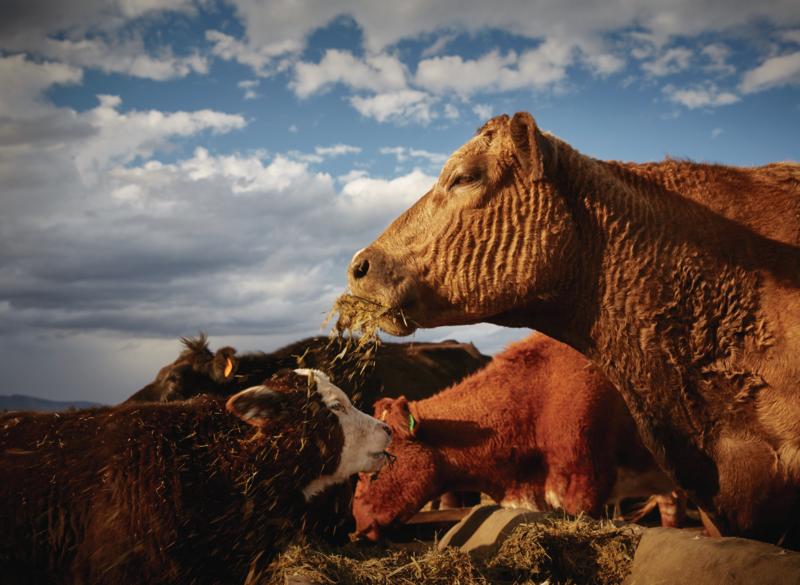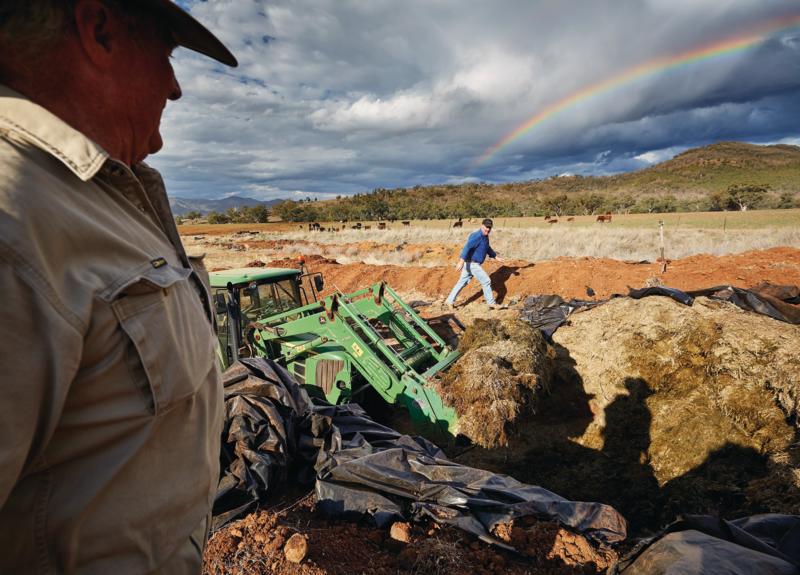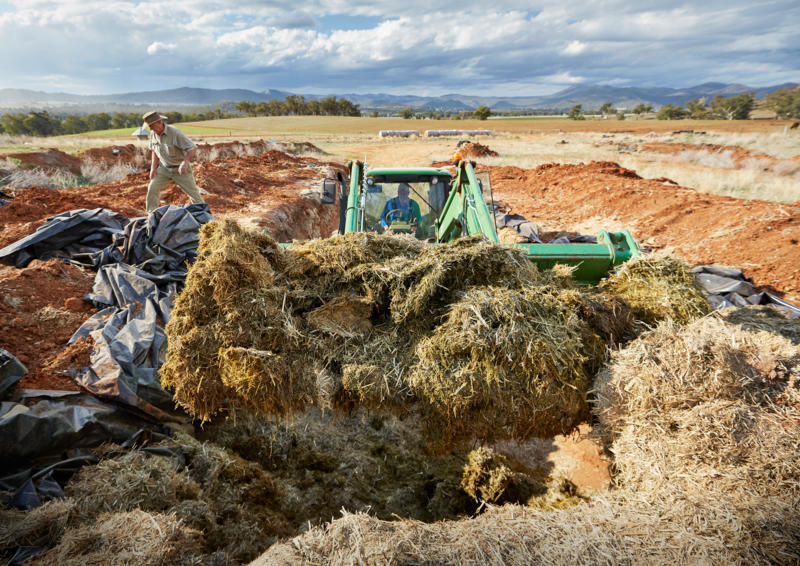Don Woods thought it would be a bright idea to store a bumper crop of forage sorghum in a silage pit in case he needed it when times weren’t as good. Twenty-six years later, that silage is proving vital in maintaining the Tamworth farmer’s core beef breeding herd and farm income in the midst of a severe drought.
Inspired by memories of his father’s dairy farming practices, Don dug a silage pit on the side of a hill in 1992 to store 160 tonnes of chopped forage sorghum. “The rain fell nicely that year and there was plenty of feed,” Don says. “I remember Dad using silage on a continuous basis on the dairy farm and decided to use it for our beef operation.
“Now we are in the driest year I have seen in 45 years, so we opened up the pit and almost all the silage has been fed out. It is supplemented with our own barley and wheat mixture, some minerals and a sprinkle of ground lupins to lift the protein content.”
Don and his son Scott run a small mixed beef herd on 123 hectares at Kootingal, east of Tamworth, and grow wheat and barley for the dual purpose of grazing and feed-grain production. The barley crops are grazed once before being reserved for a grain harvest, while the wheat crop is harvested and then processed on farm into burghul, the key ingredient in tabouli salads.
“We store the barley in silos and the wheat is steamed, dried and ground in a plant on the farm to make burghul. We use the by-products of this process as part of the feed mix,” Don says.
RELATED STORIES:
-
The drought hay crisis
-
Donated hay survey: where drought-affected farmers found relief
-
Diversifying from beef to hay production
-
Clever silo storage helps grain farmer harvest top dollar
 Caption: Angus and Shorthorn cattle feed on the sorghum at “Woodsvale” Kootingal, near Tamworth.
Caption: Angus and Shorthorn cattle feed on the sorghum at “Woodsvale” Kootingal, near Tamworth.
Before it was fed to the cattle, the silage was tested and found to have a protein content of 7.5%. When mixed with a few extra ingredients, Don says it has saved his breeding herd and enabled the farm to continue to supply yearling cattle to Woolworths within the required live-weight range of 400-500kg.
“While we did not buy in any young cattle to grain-finish this year, the silage experiment from 1992 has certainly helped in holding the condition of our breeders and their offspring. It’s also saved us thousands by not having to buy in hay and from the challenge of having to source it,” Don says.
“It really has shown the value of putting fodder away as silage in good times instead of buying more cattle.”
 GOOD LUCK: A rainbow appears as Don (left) and Scott collect sorghum from the silage pit.
GOOD LUCK: A rainbow appears as Don (left) and Scott collect sorghum from the silage pit.
After working in fodder research for 30 years, NSW Department of Primary Industries livestock research officer John Piltz agrees silage has some significant advantages when it comes to long-term drought management strategies.
“I heard of farmers opening up silage pits that were 40 to 50 years old during the drought in the early 2000s,” says John.
“Essentially it can be stored in pits indefinitely and, while you cannot compare it to ageing wine in terms of improving taste and texture, pit silage does maintain its nutritional value if kept free from air and water. In the case of wine, alcohol does the preserving. For silage, it’s the acid that does the preserving. When the acid is produced in the fermentation process, it reduces the pH, stops the process and preserves the silage.”
 Tamworth beef producer Don Woods reflects on the valuable silage that's helping maintain his breeding herd.
Tamworth beef producer Don Woods reflects on the valuable silage that's helping maintain his breeding herd.
John says plastic-wrapping silage is common practice in the dairy industry for short-term fodder storage, but storing it as either a fine-chopped product or in large bales under plastic and dirt is the best option for long-term fodder conservation.
“The extra physical barrier of the dirt stops the vermin getting in and prevents the breakdown of the plastic. One of the key factors to consider though is not to use wet or flat areas to avoid the risk of water spoiling the silage.”
John says silage can also be made from pastures, which gives small and large beef producers a long-term fodder storage option while managing pasture growth in favourable years.
READ more stories of farmer's resilience during drought:
- Drought stories of success, not charity
- Tough lessons learnt: building resilience to drought
- De-stocking: farmers making the hard choices
- Support during drought when the going gets tough
“In my opinion, you can make quality silage from just about any pasture if it is cut at the right time and stored correctly,” he says. “It can be more expensive to make than hay, but you will likely end up with a better quality feed in the long term for a pasture-based system as you can cut it and store it quickly without losing nutritional value.”
PIT SILAGE TIPS
1. Dig pits in dry, sloping land (avoid wet and flat areas).
2. Cover silage in plastic and then cover well with earth.
3. Make sure water and air can’t get to the silage.
4. Test silage for nutritional value before feeding to stock.

GOLD MINE: Don Woods (left) and his son Scott opening the silage pit where Don stored forage sorghum 26 years ago.